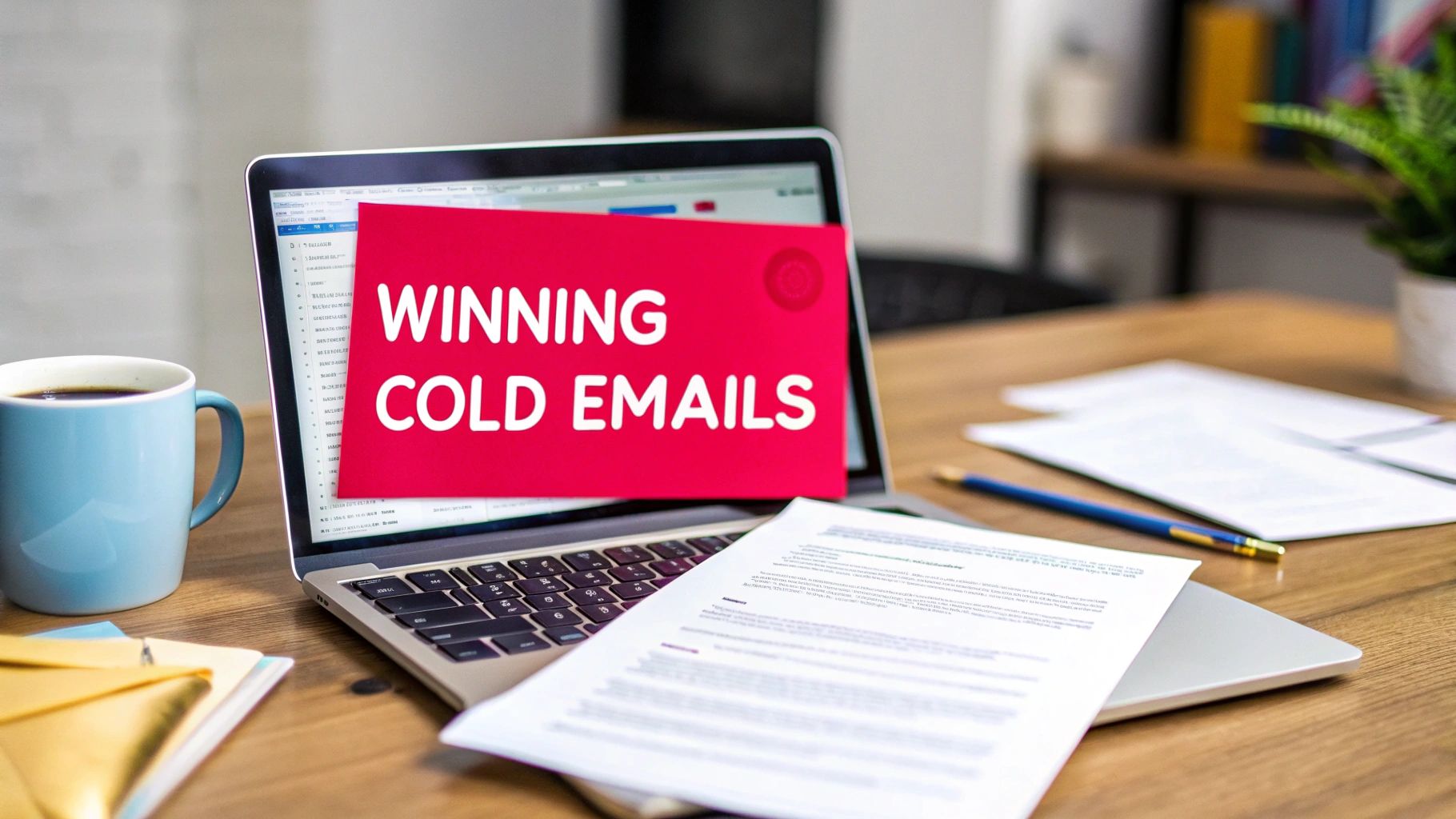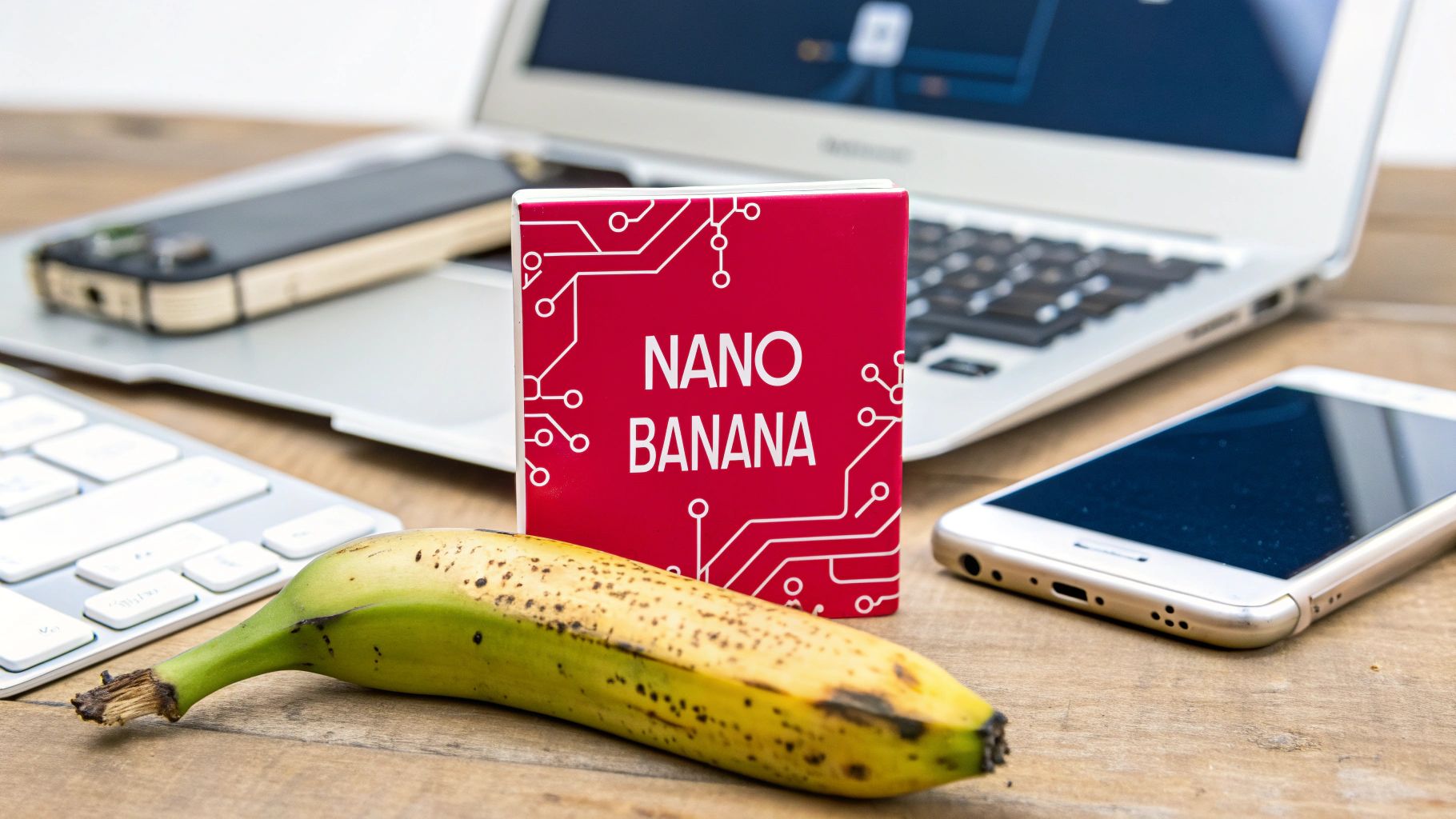In the world of B2B sales, a cold email is a powerful but often misused tool. A generic, poorly researched message is destined for the trash folder, but a strategic, well-crafted email can open doors to your most valuable clients. The difference isn't just in the words you use; it's in the underlying strategy.
This article moves beyond simple templates to dissect six proven b2b cold email examples, revealing the psychological triggers, strategic frameworks, and deep personalisation tactics that make them effective. We will break down each approach, providing not just the 'what' but the 'why' behind its success, empowering you with replicable strategies to transform your own outreach from ignored to indispensable.
While this article delves deep into the craft of email, it's important to recognise this tactic as one powerful component within a broader sales effort. Successful campaigns often integrate various outreach methods, and understanding the full picture is key. For a comprehensive overview, exploring different approaches can provide valuable context, such as these 7 proven outbound lead generation strategies, which can complement your email initiatives.
Our focus here, however, remains laser-sharp. We will explore emails built on different foundations:
- The Problem-Solution Hook
- Social Proof and Case Studies
- Personal Connections and Warm Introductions
- Question-Based Curiosity
- Value-First Education
- Referrals and Trigger Events
By understanding these core principles, you can craft emails that don't just ask for a meeting but earn it by delivering genuine value from the very first line. You will learn not just what to write, but how to think strategically about every email you send, turning a cold start into a warm conversation. Let's analyse the examples.
1. The Problem-Solution Cold Email
The Problem-Solution cold email is a classic, high-impact strategy for a simple reason: it cuts straight to the heart of what matters to your prospect. Instead of leading with your company or product, you lead with a deep understanding of a specific, tangible problem their business is likely facing. This approach immediately positions you as a helpful expert rather than just another salesperson.
The core principle, popularised by sales leaders like Aaron Ross, is to diagnose before you prescribe. By identifying a relevant pain point, you build instant rapport and demonstrate that you've done your research. The email then smoothly transitions from this shared understanding of the problem to a concise introduction of your product or service as the ideal solution. It’s one of the most effective b2b cold email examples because it prioritises the prospect's world, not your own.

Strategic Breakdown
This email’s effectiveness lies in its simple, logical flow. You start by validating a challenge the recipient is almost certainly thinking about, making them feel understood. This builds a foundation of trust before you even mention your solution.
- Problem-First Hook: The subject line and opening sentence must grab attention by referencing a specific pain point. For example, a company like Slack might target a fast-growing tech firm with a subject line like, "Internal comms at [Company Name] getting noisy?"
- Agitate with Data: After stating the problem, you can amplify its significance with a compelling statistic. For instance, "Companies lose an average of 4 hours per employee per week due to inefficient communication tools." This adds credibility and urgency.
- Solution as a Bridge: The transition to your solution should be seamless. It’s not a hard pitch but a logical next step. Example: "Our platform centralises team conversations, cutting down on internal email clutter by over 45% for clients like [Similar Company]."
- Low-Friction Call-to-Action (CTA): End with a simple, non-committal question. Instead of "Can we book a demo?" try "Are you currently exploring ways to streamline internal communication at [Company Name]?"
When to Use This Approach
The Problem-Solution framework is incredibly versatile, but it excels in specific scenarios:
- Established Industries: When targeting companies in mature sectors with well-known, recurring challenges (e.g., logistics, manufacturing, finance).
- Trigger Events: Following a company announcement like a new funding round, a major expansion, or a leadership change that will likely create new operational problems.
- Role-Specific Pain Points: When you can confidently identify a challenge specific to a job title (e.g., a Head of Sales struggling with lead attribution, or a CFO concerned with expense reporting).
This method demonstrates empathy and expertise, making it a powerful way to initiate a meaningful business conversation. By focusing on solving a problem, you reframe the interaction from a sales pitch to a strategic consultation. For more templates built on this foundational logic, you can find a variety of expertly crafted options. Find more inspiration and discover how to build upon these strategies in our comprehensive guide to business email templates on grassrootscreativeagency.com.
2. The Social Proof and Case Study Email
This email type leverages the psychological principle of social validation to build immediate trust and credibility. Instead of talking about your solution in a vacuum, you anchor your claims to the real-world success of a company the prospect knows and respects. It works by shifting the focus from "what we can do" to "what we have already done for someone just like you," which is a far more powerful message.
The core idea, championed by experts in customer success and social proof marketing like Lincoln Murphy and Katelyn Bourgoin, is that people trust their peers. When a prospect sees that a similar company, or even a direct competitor, has solved a specific problem using your service, it de-risks the decision-making process for them. This approach is one of the most compelling b2b cold email examples because it provides tangible, third-party evidence of your value before you even ask for a meeting.
The following timeline infographic visualises the powerful, metric-driven results that a social proof email aims to communicate, showing clear value achieved over a short period.

This kind of timeline demonstrates not just initial explosive growth but also sustained operational improvements, making the case study far more compelling.
Strategic Breakdown
This email’s power comes from its ability to borrow credibility. By leading with a familiar name and impressive, quantifiable results, you immediately bypass the natural scepticism that greets most cold outreach. The prospect is more likely to listen because someone they perceive as a peer has already vetted your solution.
- Relevant Hook: The subject line and opening must name-drop a relevant company. For instance, an email from Intercom to a SaaS company might have the subject, "How Atlassian reduced support tickets by 40%."
- Metric-Driven Evidence: The body of the email must focus on specific, impressive numbers. Avoid vague claims like "improved their business." Instead, say, "Shopify helped Fashion Nova achieve 600% year-over-year growth by optimising their checkout process."
- Implicit Connection: You don't need to explicitly state, "You can get these results too." The connection is implied. By choosing a case study from a similar industry, size, or model, you allow the prospect to draw their own conclusions. For example: "[Prospect Name], I saw you're also in the fast-fashion e-commerce space and thought you might find their story interesting."
- Offer More Proof: The call-to-action (CTA) should offer to provide more detail, not demand a demo. A great CTA is, "If you're interested, I can share a more detailed breakdown of the strategy they used. Would that be helpful?"
When to Use This Approach
While social proof is always powerful, this email format is most effective in certain situations:
- Competitive Markets: When your prospects are inundated with offers from similar-looking companies, a strong case study with a well-known brand can instantly set you apart.
- High-Value Solutions: For expensive or complex products, providing proof of a significant return on investment (ROI) is crucial to justifying the cost and effort.
- Targeting Ambitious Companies: When you are reaching out to a company that is known to be a fast-follower or is actively trying to emulate the success of industry leaders.
This method transforms a cold email from an unsolicited pitch into a valuable piece of market intelligence. By sharing a relevant success story, you position yourself as a helpful expert with a proven track record, making it far more likely you'll receive a positive reply.
3. The Personal Connection and Warm Introduction Email
The Personal Connection email transforms a cold outreach into a warm introduction by leveraging common ground. Instead of a generic pitch, you lead with a shared experience, a mutual connection, or a recent company event to build an immediate, human-to-human bridge. This strategy instantly differentiates you from the flood of automated, impersonal emails flooding your prospect's inbox.
The principle, championed by sales experts like Jill Konrath and Amy Volas, is that relationships drive business. By referencing something you genuinely have in common, you establish trust and show you’ve done your homework. The email then gracefully pivots from this personal touchpoint to a relevant business value proposition. This is one of the most powerful b2b cold email examples because it prioritises authentic connection over a hard sell, making the recipient far more receptive to your message.

Strategic Breakdown
This email’s power comes from its authenticity and relevance. It taps into the natural human inclination to trust people we feel connected to, even if the connection is small. This foundation of rapport makes the subsequent business conversation feel less like a pitch and more like a helpful discussion.
- Genuine Connection Hook: The subject line and opening must be specific and sincere. For example, "Saw your post on AI in marketing" or "Fellow [University Name] alum here." This immediately signals that the email is personalised and not a mass blast.
- Bridge to Business Value: After establishing the connection, transition smoothly to the business context. Example: "Your post about scaling your content team really resonated. Many fast-growing SaaS firms we work with face a similar challenge when trying to maintain quality at scale."
- Provide Relevant Insight: Connect your solution directly to their context. For instance, "We help companies like [Similar Company] automate content distribution, freeing up their creative teams to focus on strategy, which seems aligned with your goals at [Company Name]."
- Interest-Gauging CTA: Keep the call-to-action light and focused on exploring the idea further. Instead of asking for a meeting, try, "Curious to know if optimising content workflow is a priority for you this quarter?"
When to Use This Approach
The Personal Connection framework is highly effective but requires thoughtful research. It’s ideal in these situations:
- Leveraging Mutual Connections: When you share a professional contact on LinkedIn. Always ask the mutual connection for permission to use their name first for maximum impact.
- Post-Event Follow-Up: After attending the same webinar, conference, or industry event. You can reference a specific speaker or topic to make the connection stronger.
- Responding to Social Signals: When a prospect or their company publishes a significant article, wins an award, or announces a new initiative. This shows you are paying attention to their world.
- Shared Background: Capitalising on commonalities like a shared alma mater, previous employer, or membership in a professional group.
This method builds rapport before ever mentioning a product feature. By leading with a genuine, personal touch, you demonstrate respect for the prospect's time and position yourself as a thoughtful, well-researched peer, not just another vendor. It is a cornerstone of relationship-based selling in the modern B2B landscape. For more inspiration on building these types of authentic outreach campaigns, explore our complete guide to business email templates on grassrootscreativeagency.com.
4. The Question-Based Curiosity Email
The Question-Based Curiosity email leverages human psychology to its advantage by leading with a compelling question instead of a statement or a pitch. This technique is designed to stop a busy prospect in their tracks and make them think. By asking a relevant, insightful question about their business, you shift the dynamic from a sales pitch to a peer-to-peer conversation, immediately sparking engagement and positioning yourself as a thoughtful industry expert.
This approach, with roots in methodologies like Neil Rackham’s SPIN Selling and the insight-based questioning of The Challenger Sale, is powerful because it makes the prospect the hero of the story. You are not telling them what their problems are; you are inviting them to share their perspective. This simple act of asking a good question is one of the most effective b2b cold email examples for building rapport and opening doors that would otherwise remain closed.
Strategic Breakdown
The effectiveness of this email hinges entirely on the quality and relevance of the opening question. A generic or self-serving question will be ignored, but a sharp, specific, and thought-provoking one encourages a reply by tapping into the recipient's professional curiosity and challenges.
- Curiosity-Driven Hook: The subject line and opening must pose a question that is impossible to answer with a simple 'yes' or 'no'. It should be directly related to the prospect’s role or industry. For example, a cybersecurity firm might ask a CTO, "How are you adapting your data protection strategy for the new AI-driven threat landscape?"
- Provide Context (The "Why You"): Immediately after the question, briefly explain why you are asking them specifically. This prevents your email from feeling like a random survey. Example: "I'm reaching out because I saw [Company Name] recently expanded into the EU, and I specialise in helping SaaS firms navigate the complexities of GDPR compliance that come with such a move."
- Offer Value, Not a Pitch: Your goal is not to sell in the first email. Instead, offer a piece of insight or data related to their potential answer. Example: "Many CTOs we speak to are concerned about X, and we found that implementing Y can mitigate that risk by up to 30%."
- Open-Ended Call-to-Action (CTA): The CTA should continue the conversational tone. Instead of asking for a meeting, try to deepen the dialogue. For example, "What’s your current priority when it comes to [the challenge mentioned]?" or "Curious to hear your thoughts on this."
When to Use This Approach
The Question-Based Curiosity email is highly effective but requires good research to execute well. It shines in the following situations:
- Targeting Senior Decision-Makers: C-suite executives and directors are often more responsive to strategic questions that challenge their thinking than to standard feature-benefit pitches.
- Complex or Evolving Industries: When dealing with sectors like fintech, AI, or renewable energy, where challenges are new and solutions are not yet standardised, a good question can open up a valuable strategic discussion.
- When You Have Unique Insight: If you possess proprietary data, have worked with a direct competitor, or have a unique perspective on a recent industry trend, you can frame a question that only you are equipped to discuss.
This method transforms a cold outreach into a warm, consultative dialogue. By prioritising the prospect's intellect and challenges, you demonstrate respect and expertise, making it far more likely they will invest their time in a response.
5. The Value-First Educational Email
The Value-First Educational Email flips the traditional sales model on its head. Instead of asking for something, you give something away, positioning yourself as a generous expert and trusted resource from the very first interaction. This approach is built on the principle of reciprocity; by providing genuine, no-strings-attached value upfront, you build goodwill and earn the right to ask for a conversation later.
This strategy, popularised by content marketing pioneers like Marcus Sheridan and Jay Baer, focuses on being genuinely useful. You lead with an exclusive industry report, a helpful checklist, or a piece of insightful analysis that your prospect can use immediately, whether they reply to you or not. This makes it one of the most effective b2b cold email examples for building long-term relationships because it demonstrates empathy and a deep understanding of your prospect’s challenges.
Strategic Breakdown
The power of this email lies in its selflessness. It shifts the dynamic from a sales pitch to a helpful consultation, disarming the prospect’s natural sales defences and making them more receptive to future communication.
- Valuable, Relevant Hook: The subject line and opening must clearly communicate the value being offered. A subject line like, "A few thoughts on [Prospect's Industry] talent retention" or "Exclusive benchmarks for SaaS churn" immediately signals that the email contains useful information, not a sales pitch.
- Contextualise the Value: Don't just attach a resource; explain why it is relevant to them right now. For instance, "I noticed you're hiring several new sales managers, so I thought our recent report on scaling sales teams might offer some valuable insights." This shows you've done your homework.
- Minimal Self-Promotion: The email should be 90% about the value you're providing and only 10% about you or your company. A brief mention is all that's needed, such as, "At [Your Company], we help businesses implement these strategies to reduce churn."
- Soft, Value-Oriented CTA: The call-to-action should not ask for a meeting. Instead, it should encourage engagement with the value provided. Try something like, "The data on page 7 is particularly interesting for companies of your size. Let me know what you think," or "Happy to discuss any of the findings if they resonate with your current goals."
When to Use This Approach
The Value-First Educational email is a powerful tool, particularly effective in nurturing long-term, high-value relationships. It excels in these situations:
- Complex or Niche Industries: When prospects need to be educated on the problem before they can even consider a solution (e.g., cybersecurity, advanced analytics, specialised consulting).
- Building Brand Authority: Ideal for new companies or consultants trying to establish themselves as thought leaders in a crowded market.
- Targeting Senior Decision-Makers: High-level executives are short on time and appreciate concise, high-value insights over a direct sales pitch.
- Long Sales Cycles: When the path to a deal is a marathon, not a sprint, this approach allows you to build a foundation of trust over time through multiple value-driven touchpoints.
By leading with generosity, you reframe the entire sales process. You're no longer a salesperson trying to hit a quota; you're an industry expert offering a helping hand. This foundation of trust can be further nurtured and scaled, and you can delve into how to build upon these initial interactions in our guide to crafting an email marketing automation strategy on grassrootscreativeagency.com.
6. The Referral and Trigger Event Email
The Referral and Trigger Event email capitalises on a critical sales principle: timing is everything. Instead of sending a cold email out of the blue, this strategy leverages a specific, public event in the prospect’s company, such as a new funding round, a key leadership hire, or a major product launch. This approach transforms a cold outreach into a warm, relevant, and timely conversation.
The core idea, championed by sales experts like Trish Bertuzzi, is that these events create predictable challenges and opportunities. By referencing the event, you demonstrate that you are not just spamming a list but are genuinely paying attention to their business journey. This instantly builds credibility and makes your outreach feel like a well-timed, helpful intervention rather than a generic sales pitch. This makes it one of the most powerful b2b cold email examples for cutting through the noise.
Strategic Breakdown
This email’s power comes from its contextual relevance. The trigger event acts as a natural reason for reaching out, making the prospect more receptive to hearing how you can help them navigate the very changes they are currently experiencing.
- Timely Hook: The subject line and opening must immediately reference the specific event. For instance, "Congrats on the Series B funding!" or "Thoughts on scaling after the [Product Name] launch?" This creates an instant, newsworthy connection.
- Connect to a Challenge: Link the trigger event directly to a relevant business problem. For example, "Scaling post-funding often puts immense pressure on customer support teams. We saw this with [Similar Company], who struggled to maintain response times."
- Position as a Solution: Present your service as the logical solution to the challenge created by the event. Example: "Our AI-powered chatbot helped them handle a 300% increase in support tickets without hiring more agents."
- Low-Friction Call-to-Action (CTA): The CTA should be consultative and tied to the event. Instead of a hard demo request, try something like, "Is scaling your customer success team a priority for you in the next quarter?"
When to Use This Approach
The Trigger Event framework is highly effective but requires diligent monitoring and quick action. It's best deployed in these situations:
- Company Growth Milestones: When a company announces a new funding round (e.g., Series A, B, C), an acquisition, or plans for international expansion. These events signal a need for new tools to manage growth.
- Leadership Changes: A new executive hire (e.g., VP of Sales, CMO, CTO) often brings a new budget and a mandate for change. They are actively looking for solutions to make their mark in the first 90 days.
- Product Launches or Bad Press: A new product launch creates needs around marketing, sales, and customer support. Negative press or poor reviews can create an opening for a solution that addresses the underlying problem.
By aligning your outreach with a prospect’s current reality, you demonstrate sharp business acumen and a genuine interest in their success. This strategy shifts the dynamic from a cold pitch to a relevant, strategic discussion. To see how this initial outreach can evolve, explore these lead nurturing campaign examples on grassrootscreativeagency.com for the next steps in the customer journey.
6 B2B Cold Email Types Comparison
| Email Type | ⭐ Expected Outcomes | 🔄 Implementation Complexity | ⚡ Resource Requirements | 💡 Ideal Use Cases | 📊 Key Advantages |
|---|---|---|---|---|---|
| The Problem-Solution Cold Email | 15-25% higher conversion; demonstrates deep understanding | High; requires extensive research | Moderate; industry data gathering and personalization | SaaS, consulting, B2B solutions with clear ROI | High relevance; positions sender as industry expert |
| The Social Proof and Case Study Email | 18-30% response when targeted; builds credibility | Medium; need permission and targeted case studies | Moderate; collecting and tailoring client success stories | Industries with relevant case studies | Builds trust; reduces risk; creates FOMO effect |
| The Personal Connection and Warm Introduction Email | 35-50% response with genuine connections | High; time-intensive personalized research | High; identifying and verifying mutual connections | Networking-heavy sales; relationship-driven industries | Builds trust fast; differentiates from generic cold emails |
| The Question-Based Curiosity Email | High engagement; incites thoughtful responses | Medium-High; requires deep industry knowledge | Moderate; crafting thoughtful questions | Consultative sales and industries needing dialogue | Drives two-way conversation; less salesy |
| The Value-First Educational Email | Builds long-term trust; positions sender as expert | Medium-High; content creation or curation | High; producing valuable insights and resources | Brand awareness; thought leadership-oriented campaigns | Provides value regardless of response; often shared |
| The Referral and Trigger Event Email | High relevance leads to increased responses | Medium; requires monitoring systems | Moderate; tools for event tracking and quick outreach | Situational outreach based on company events | Timely; urgent; shows genuine business interest |
From Examples to Execution: Building Your Winning B2B Email Strategy
We’ve dissected a powerful arsenal of b2b cold email examples, from the direct Problem-Solution framework to the subtle Value-First educational approach. These templates are not just scripts to be copied and pasted; they are strategic blueprints designed to open doors, start conversations, and build the foundations of valuable commercial relationships. The true power lies not in any single template, but in understanding the core principles that make them work.
Each example hinges on a fundamental shift in mindset: moving from a self-centred sales pitch to a prospect-centric value proposition. Whether you're leveraging social proof, referencing a shared connection, or capitalising on a timely trigger event, the goal remains the same. You must demonstrate that you have done your homework, understand your prospect's world, and have a genuinely valuable reason for being in their inbox.
Synthesising the Strategies for Maximum Impact
The most sophisticated outreach campaigns rarely rely on just one tactic. Imagine combining the precision of a Trigger Event Email with the authority of a Social Proof and Case Study Email. You could mention a company's recent funding round (the trigger) and then immediately pivot to how you helped a similar, newly-funded company achieve a specific, relevant outcome.
The key is to view these examples as modular components. You can mix and match elements to create a hybrid approach perfectly tailored to your ideal customer profile (ICP) and unique value offering. This adaptability is what separates generic, low-performing campaigns from highly personalised, revenue-generating machines.
Your Actionable Roadmap to Cold Email Mastery
Transitioning from theory to practice is the most critical step. Staring at a list of b2b cold email examples is one thing; executing a successful campaign is another. Here is a clear path forward to turn these insights into tangible results:
- Define Your Core Strategy: Review the six archetypes we covered. Which one or two align most closely with your business model and the primary pain points you solve? A B2B SaaS company might favour the Problem-Solution or Case Study approach, while a consultant might lean towards the Value-First or Question-Based email.
- Build Your Master Template: Based on your chosen strategy, draft a master template. This isn't for sending; it's your foundation. Structure it with clear placeholders for personalisation, such as
[Prospect Name],[Company Name],[Specific Observation], and[Relevant Metric]. - Commit to Deep Personalisation: This is non-negotiable. For every email, dedicate time to researching the individual and their company. Find a recent interview, a LinkedIn post, a company announcement, or a new role change. This single detail is often the catalyst that transforms a cold email into a warm conversation.
- Launch, Measure, and Optimise: Start small. Send a batch of 20-30 highly personalised emails and meticulously track your metrics. Pay close attention to open rates (subject line effectiveness), reply rates (body copy resonance), and positive reply rates (CTA clarity). Use this data to refine your approach for the next batch.
To further inspire your outreach and strengthen your tactical approach, exploring more top cold email examples can provide a wealth of ideas. Ultimately, mastering B2B cold email is a process of continuous improvement, driven by empathy, strategic thinking, and a commitment to providing value at every touchpoint. By embracing this philosophy, you will not only fill your pipeline but also build a reputation as a thoughtful, credible industry partner.
Ready to turn these examples into a high-performance lead generation engine for your business? The team at Grassroots Creative Agency specialises in crafting and executing data-driven B2B email marketing campaigns that get results. We handle the strategy, research, and optimisation, so you can focus on closing the deals we generate. Contact Grassroots Creative Agency today to build your predictable pipeline.








